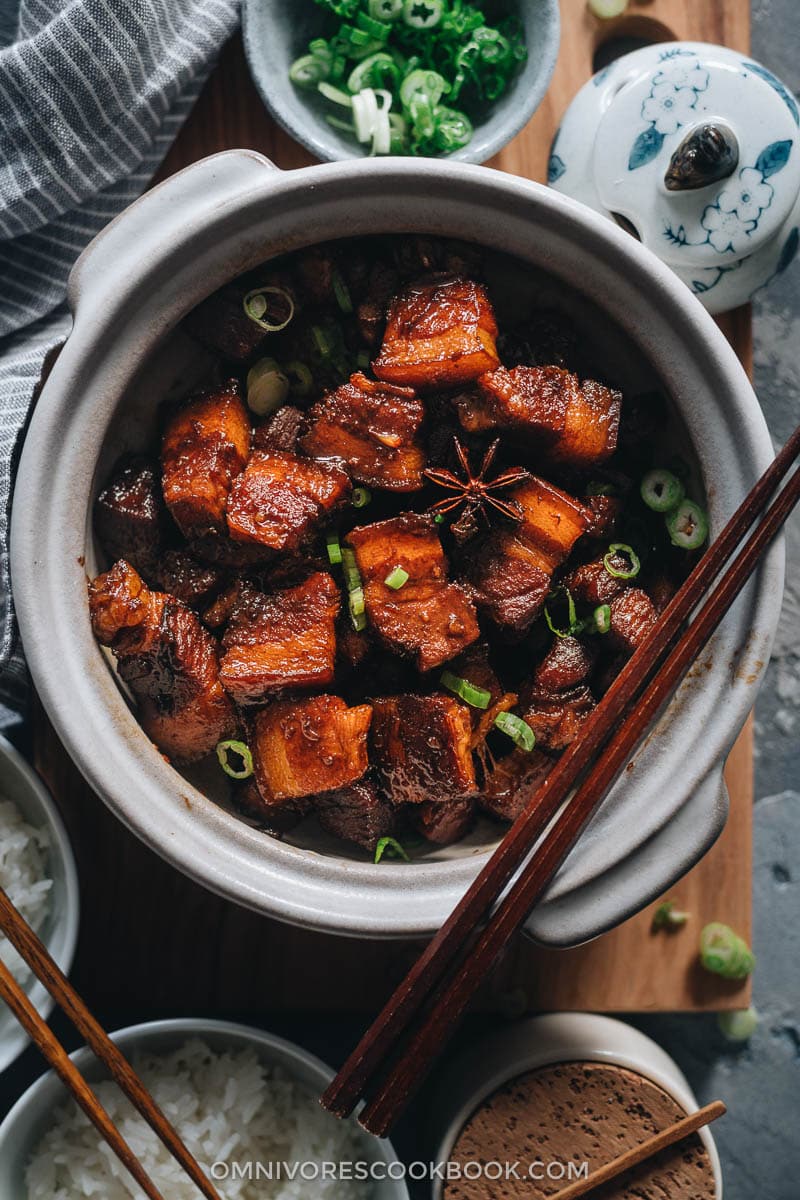
Hong Shao Rou (红烧肉), or red braised pork, is a beloved dish in China. Depending on the region, there are many different approaches to cooking it. Some versions taste sweeter, some taste more savory, while others taste spicy. However, all of them use the red braise cooking method to give the pork a glossy caramelized char. The pork is then simmered in liquid with Shaoxing wine, soy sauce, and plenty of aromatics until melt-in-your-mouth tender.
In the past I shared how my family braises pork. For example, the Northern Chinese style Braised Pork Ribs and Braised Pork Feet. The Hong Shao Rou recipe I’m sharing today is closer to Shanghai style, which is the more popular version in the US.
I can’t wait to show you how easy it is to cook this dish in your own kitchen!
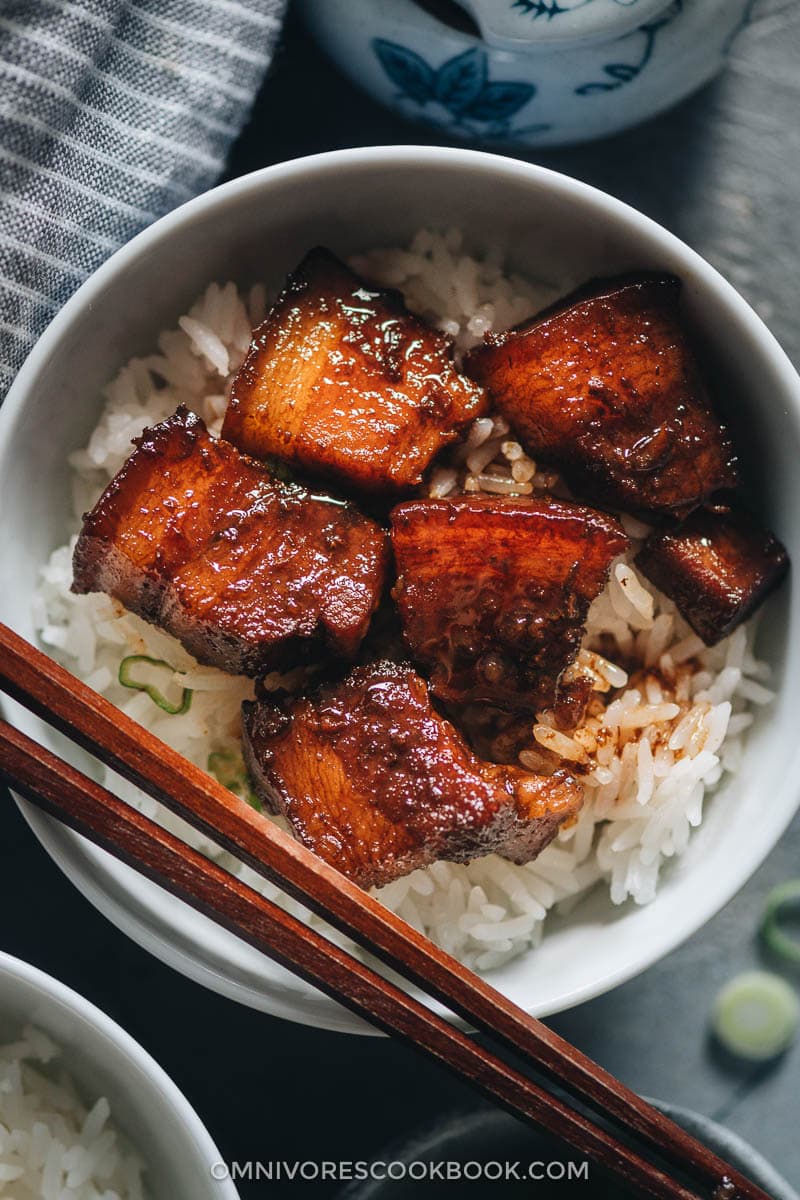
Hong shao rou ingredients
How to purchase pork belly
The authentic red braised pork always uses skin-on pork belly. You can usually find it in a Chinese market. I’ve even seen gorgeous cuts of pork belly at Costco. Personally, I always pick the leanest cut I can find, so the final version is less greasy. If you don’t like pork skin, the skinless type also works well. Most Korean and Japanese markets sell skinless pork belly. Some US grocery stores sell the cut too, but it tends to be very fatty at those places.
How to cut pork belly
Pork belly shrinks quite a bit during cooking. I prefer to cut it into 1” (2.5 cm) chunks, so it will absorb flavor well while holding its shape. Note, depending on the cut you get, the best shape to cut it into might be a rectangle (see the picture below). I got this sliced pork belly in Chinatown. I would cut them into long rectangles instead of further cutting them into squares. It’s important to leave the lean meat attached to the fat, so the meat will become extra tender from the braising.
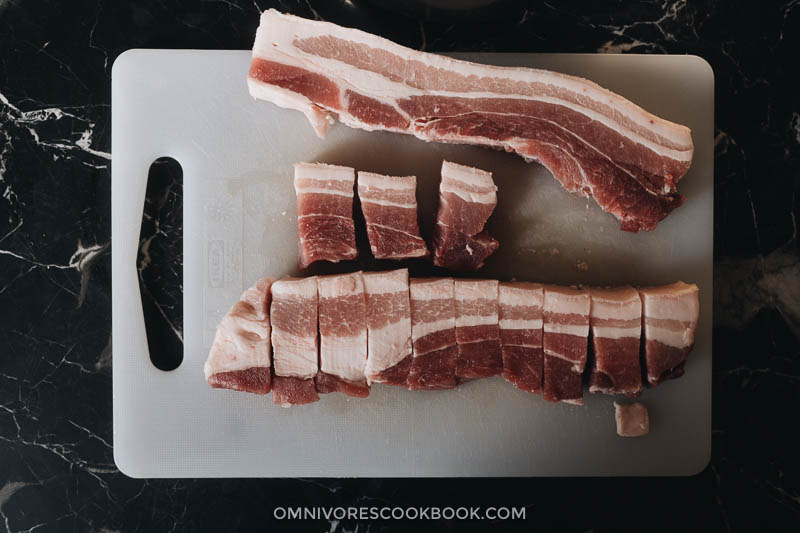
Hong shao rou braising ingredients
It doesn’t take many ingredients to make hong shao rou. You will need:
- Green onion
- Ginger
- Shaoxing wine
- Light and dark soy sauce
- Sugar
- Star anise
How to cook hong shao rou
1. Blanching the pork
This step is very important in most Chinese braised pork dishes. It gets rid of the impurities from the pork and imparts the meat with aromatics. The cooking liquid is reserved and used at the braising.
All you need to do is:
- Cover the pork with water and cook it with the aromatics
- Skim the foam from the surface
- Rinse the pork with cold tap water to further remove the impurities
- Drain and dry the pork thoroughly with paper towels (very important – it will prevent splatter when you cook the pork in the hot sugar)
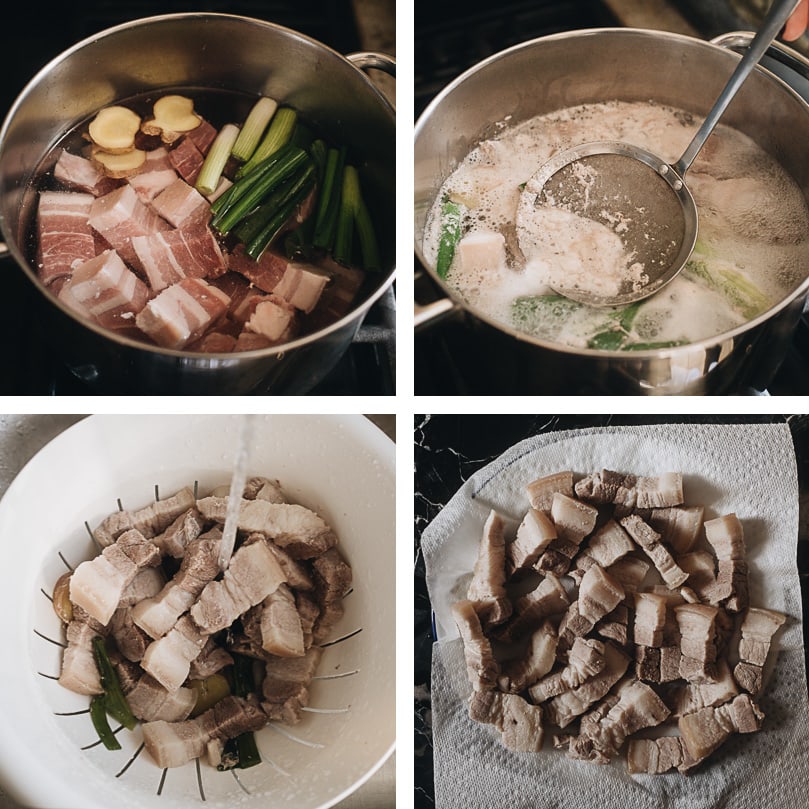
2. Sear the pork in sugar (炒糖色)
It’s a technique used in many red braised dishes. By melting sugar in oil, then cooking the pork in the syrup that results, the pork will be browned immediately with a beautiful caramel color. It will add depth of flavor and give the pork that shiny look at the end of the cooking.
While the method might sound daunting, it’s actually quite easy. All you need to do is to ensure that you dry the pork thoroughly and use a pot without any water on it. So it won’t cause any splatter.
- Sprinkle the sugar in the pan and add the oil
- Cook until the sugar melts and the color is amber
- Brown the pork in the melted sugar
- You might need to brown the pork in two batches depending on the size of the pan
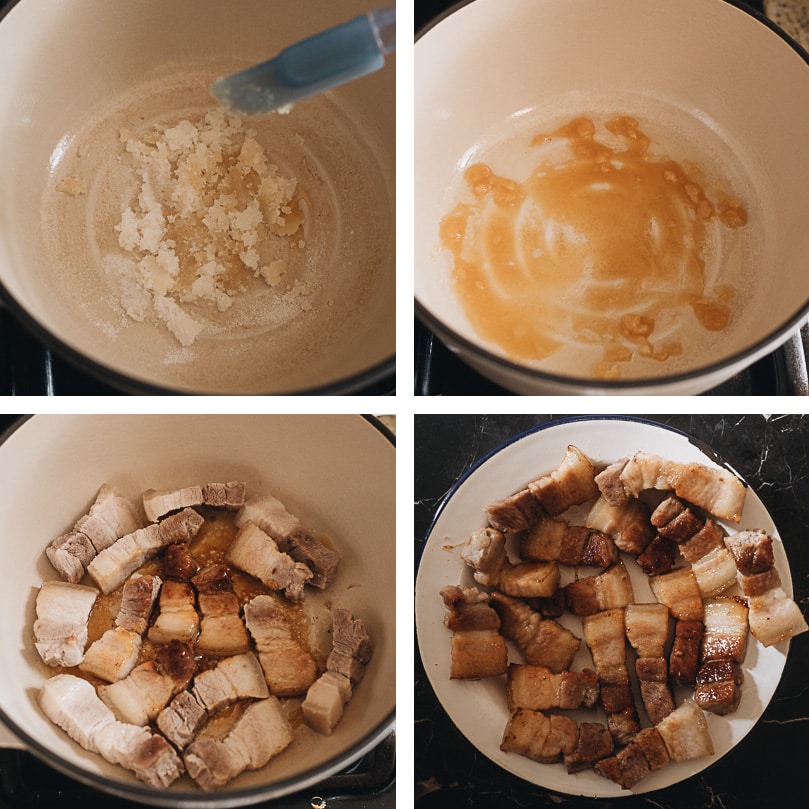
3. Braising
The easiest part!
- Add the browned pork, the braising liquid, and the aromatics.
- Braise until the broth is reduced to a thick glossy sauce and the pork is tender.
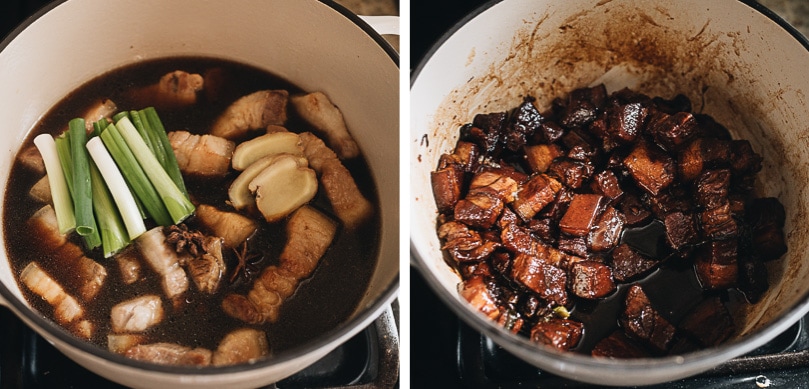
Side dishes to serve with hong shao rou
Hong Shao Rou is a very rich dish. Consider pairing it with steamed rice and leafy vegetables to create a balanced meal. Some side dishes that go well with it include:
- 4-Ingredient Baby Bok Choy Stir Fry
- Chinese Pickled Cabbage (A Quick Pickle Recipe)
- Easy Chinese Cucumber Salad
- Chinese Seaweed Salad
- Stir-Fried Pea Shoots with Garlic
This red braised pork also holds up very well and is freezer-friendly. Make it ahead and portion it out, so you can have delicious feasts throughout the busy week!
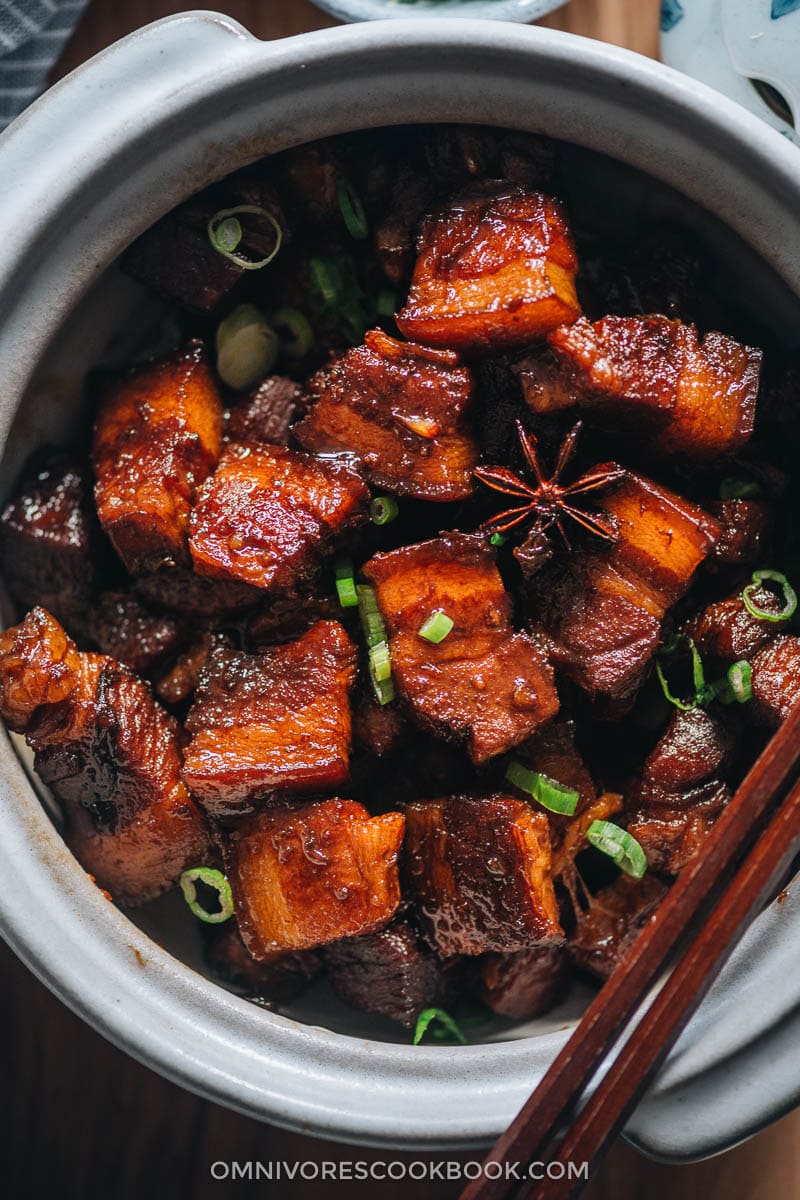
More delicious make-ahead recipes
- Chinese Chili (Sichuan Style)
- Char Siu (Chinese BBQ Pork)
- African Chicken (Macanese One-Pan Chicken Curry)
- Chinese Beef Stew with Potatoes
- Mom’s Best Braised Pork Ribs
If you give this recipe a try, let us know! Leave a comment, rate it (once you’ve tried it), and take a picture and tag it @omnivorescookbook on Instagram! I’d love to see what you come up with.
Chinese Cooking Made Easy
Are you new to this website? This free email series is a great place to start. I’ll walk you through a few of my most popular recipes and show you how and why they work. You’ll quickly start to cook better Chinese food in your own kitchen.

Hong Shao Rou (Red Braised Pork, 红烧肉)
Ingredients
- 1.5 to 2 lbs pork belly , cut into 1” (2.5 cm) cubes
Blanching Liquid
- 2 green onions , cut into 2” (5 cm) pieces
- 1/2" ginger , sliced
Braising Liquid
- 2 tablespoons peanut oil (or vegetable oil)
- 3 tablespoons sugar
- 1/3 cup Shaoxing wine (or dry sherry)
- 2 cups reserved blanching liquid
- 3 tablespoons light soy sauce (or soy sauce)
- 1 1/2 tablespoons dark soy sauce
- 1" ginger , sliced
- 3 green onions , cut into 2” (5 cm) pieces
- 2 whole star anise pods
Instructions
- In a medium-sized pot add the pork belly and enough water to cover it completely. Make sure there is some space between the water level and the lip of the pot to avoid boiling over and to make skimming easier.
- Add the green onions and ginger. Cook over high heat until the water reaches a full boil. Boil for 5 minutes, using a fine mesh strainer (or a ladle) to skim and discard the brown foam from the top, until the liquid is clear.
- Strain the pork and reserve the blanching liquid. Rinse the pork with running tap water to stop the cooking and rinse away any scum that may have stuck to it.
- In a separate medium-sized dutch oven or pot (make sure it is completely dry to avoid the oil and sugar splattering), add the sugar and oil. Heat over low heat until the sugar is melted and begins to brown; look for an amber color. Try to avoid stirring the sugar while melting it. Instead, swirl the whole pot.
- Once the caramel is a light amber color, carefully add the pork chunks by gently placing them into the caramel to minimize splashing or splattering. Depending on the size of your pot, you might need to add the pork in two batches.
- Turn the heat up to medium-low and brown the pork in the caramel, about 1 minute on each side. Be careful not to burn the sugar.
- Add the cooking wine and scrape with a wooden spatula to release any brown bits from the bottom of the pan. Add the reserved blanching liquid, light soy sauce, dark soy sauce, ginger, green onions, and star anise.
- Turn to medium-high heat until the broth comes to a boil. Turn to medium-low or low heat so the broth reduces to a simmer. Cover the pot, leaving a finger-width gap to allow the steam to escape. Simmer for 1 hour and 30 minutes. Stir 2 to 3 times during the simmering.
- If the pork has turned tender but the sauce isn’t fully reduced, remove the lid and bring the heat up to medium. Cook for another 10 or 15 minutes, until the liquid is reduced to a glaze consistency. Keep an eye on the pot during the process and stir to prevent burning on the bottom.
- Serve the pork with the glaze over steamed rice as a main course.
- You can store the leftovers in a sealed container in the fridge for 4 to 5 days or in the freezer for a month. To reheat the frozen pork, thaw it in the fridge overnight, then steam it until fully heated through, 15 to 20 minutes. If you want to reheat the pork in the microwave, cover the bowl with a plate to prevent oil splatter.
Video
Nutrition
Have a question or feedback? Add a Comment
Did you make this? I want to see! Tag @OmnivoresCookbook on Instagram, and rate the recipe below.
Lilja Walter is a part of the Omnivore’s Cookbook team and worked closely with Maggie to develop and test this recipe.

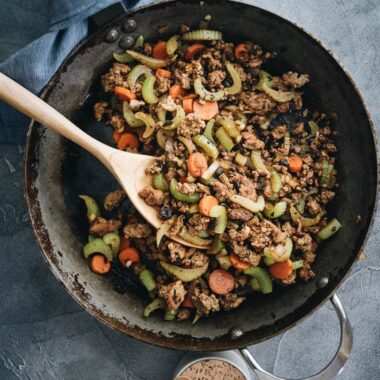
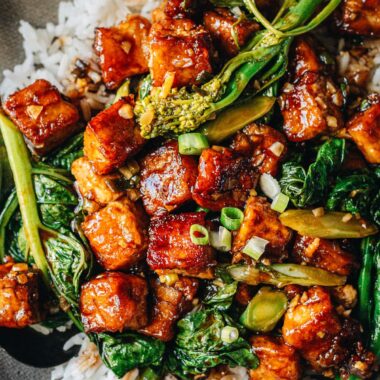
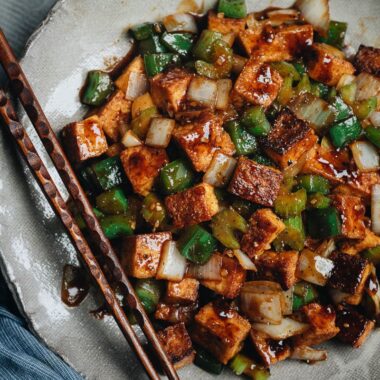
Emily S
I’ve made pork belly a few times with a different recipe but I wanted to try something new yesterday, thanks for the recipe! The braising sauce was tasty and the pork was tender after just 1.5 hours, vs my usual recipe of 3 hours.
I did have trouble caramelizing the sugar and oil though, on a low (2) to medium (5) heat. I did use cane sugar instead of white sugar but the melting point should be similar. I wasn’t able to get my sugar to brown like your video, it stayed fairly white still and I had to add a bit more oil as the sugar was getting clumpy.
Any tips on what I should do next time to achieve the brown colour? Your notes mentioned low heat so I didn’t want to turn it up too high and risk burning it.
Maggie Zhu
Browning the sugar in a dutch oven is a little tricky. Traditionally, the cooking is done in a round bottom wok, so the sugar will be fully submerged in the oil, which helps with even browning. When using a flat bottom pot, it’s hard to fully submerge the sugar in the oil. What you can do is:
– Use a little more oil, 3 tablespoons instead of 2 tablespoons.
– Sprinkle the sugar as even as possible onto the oil, to ensure all the sugar is soaked in the oil.
– Tilt and swirl the pot very slightly if the sugar is not fully covered by the oil.
If possible, try not to touch the sugar at all, because it leads to crystallization.
Your goal is to melt all the sugar and get most of them to the amber color, and it’s totally OK if some sugar has turn to syrup but not browned.
After you add the pork and start cooking, the syrup coats the pork and it will brown a more if you cook them a little longer.
That being said, the browning process helps more with the pork color. If you didn’t melt the sugar completely, it won’t affect the taste.
Karen
Made this last night, it was easy to find the ingredients at my local Asian market. Got the pork belly from Costco. My friends all loved it! Great flavor with the star anise and the ginger. Thank you for the detailed photos, I had not caramelized sugar in oil before and the photos helped a lot. I would definitely make this again!
Emma
Hi this was delicious an absolute hit. So much so I am going to make it for a Christmas party but do you think it would freeze ok?
Maggie Zhu
Yes! The dish freezes really well. When you reheat, the best way is to let it thaw in the fridge until fully thawed, then steam the meat for the best texture. If it’s a bit batch, you can also reheat it in the oven (dutch oven with lid on) or over the stovetop (medium low heat, stir frequently to prevent burning). Do not reheat in the microwave. Because pork belly is fatty, it might make pop sound in the microwave due to uneven heating.
Emma
Thanks so much. If you have other recipes that you recommend freezing I would love to know as I am trying to as smuch in advance as possible!
Maggie Zhu
Most of the stew / braised meat dishes are great for freezing, for example:
https://omnivorescookbook.com/chinese-beef-stew/
https://omnivorescookbook.com/pressure-cooker-curry-beef-stew/
https://omnivorescookbook.com/beer-duck/
https://omnivorescookbook.com/recipes/moms-best-braised-chicken-with-mushrooms
https://omnivorescookbook.com/braised-coca-cola-chicken-wings/
Ariadne
I’ve made this a couple of times and it was delicious but this time the lean part of the pork was reallt chewy and dry. Any idea why this could be?
Maggie Zhu
I wonder if you used a higher heat for braising the meat this time. The broth should be simmering the whole time. If you use a high heat, it might over cook the lean part.
Ross
Would this recipe work with 1.5″ pork sirloin cubes braised in the oven? Oven temp? 275 to 300 F?
Maggie Zhu
I’ve never test out the oven braising method but I think it will work.
Matthew
After living in Shanghai for a year this was the dish I missed the most when I got home. I’ve tried a few different recipes, and this one gets the closest to what I remember. Thanks for sharing!
Diana M
Can I use pork shoulder instead of pork belly?
Maggie Zhu
Yes you can! I love using pork shoulder in this dish because it’s less fatty and the meat will become so tender at the end.
Bob
This recipe is great. Especially like preparing the blanching water with ginger and onions — that helps a lot!
One question: any thoughts about how to reheat this. When using a steamer, is the bottom of the steamer lined with something? I tried using the steamer once to reheat the dish and it seemed to loose a bit of flavor. Am planning a dinner party and would like to prepare this dish the day before.
Maggie Zhu
For reheating, you need to put the pork and the sauce in a small bowl. The bowl needs to be set on a rack, so it’s away from the water. Depending on the steamer set up you’re using, there are different ways to set it up (for example, bamboo steamer can be set up on a wok, or on a rack in a large deep pot). The key is to keep the bowl away fro the water, so the water won’t get into the bowl and diute the dish when boiling.
katie
so so so delicious. my family loved this dish and will be making again!
Elinor
Never thought I’d make a hong shao rou as good as a restaurant in China. The fat just melts in your mouth. Thank you SO much for this recipe.
Yani
Delicious! Family really enjoyed it. Thank you for enabling me to cook all these Chinese dishes that I love!
RM
I’ve made this so many times over the past year and it’s one of my favourite dishes ever. Even my dad who’s a picky eater absolutely loves it. Thanks!
Cam
I cannot eat pork for health reasons, but I love making this recipe for my brothers (three of them). One of them asked for this on his birthday. He LOVES pork.
Eunhi
Hi, i have tried this and turned out so delicious and i am going to try once again for a dinner tonight for my guest. Thanks for introducing this amazing simple but so much flavoursome dish.
Aru
This was amazing!!! Thank you so much for sharing this recipe!!
Alan Poulter
We used Pork Belly without the skin and it worked really well, so much flavour, very easy to follow all the steps, we’ll at least be able to produce good food now that we have found this website. Thank you Maggie
Kristjana
Have been wanting to make this particular dish for a while now. So glad I found this recipe because it’s absolutely delicious and on point with the measurements. I doubled the recipe and served it with sautéed Bok Choy and of course rice. This is one good dish!
Tom Lee
I love almost all the recipes on this site, but this is one of my favourites – and is a favourite with my partner, too! My father used to cook this for me when I was a child and I’m so pleased I’ve now learnt to do it as well.
Andy
Hi! Is this the same flavor with the canned ones? The stewed pork from Gulong or Narcissus brand?
Melissa M
This is one for the record books! I made it as close to as written as possible, only I had run out of shaoxing wine so I used sake instead. We also used pork shoulder, since it’s what we had on hand and it really worked out great since the pork shoulder had a very thick layer of fat/skin similar to pork belly. Served over slightly sticky rice and a side of Chinese sautéed veggies and smashed cucumber & wood ear mushroom salad. Absolutely heavenly recipe with plenty of aromatics and the perfect amount of sweetness. The pork fat was the best part! I will be making this again many many more times! Thank you
Maggie Zhu
So happy to hear you liked this one! I LOVE using pork shoulder instead of pork belly lol It’s a bit leaner, the meat is nice and moist once cooked, and the fat layer is thiner so it’s really perfect. Your meal sounds perfect 🙂